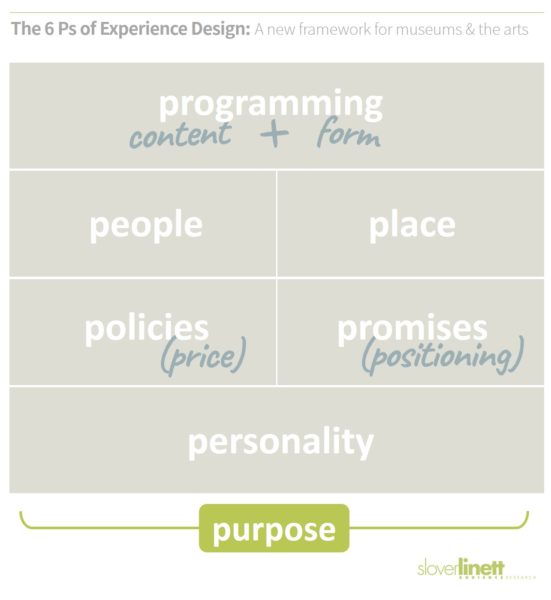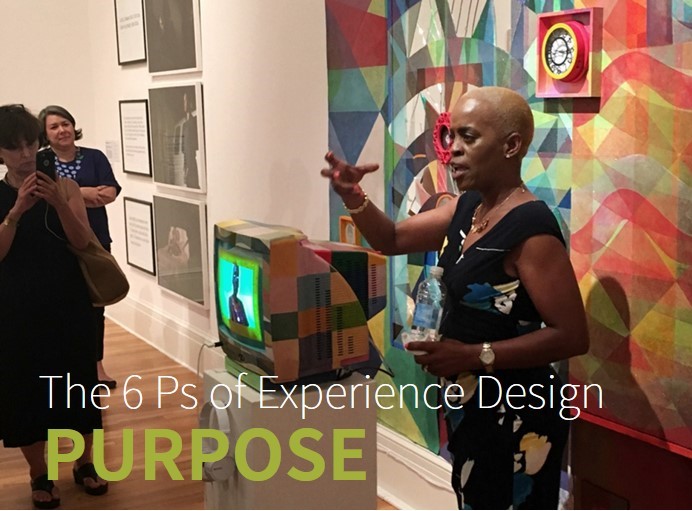News & Notes
Purpose: The emerging question (6 Ps of Experience Design)
This is the last in a series of posts about our new framework for cultural engagement, The 6 Ps of Experience Design. If you haven’t read the preceding posts, you may want to start at the beginning.
- Policies
- Promises
- Personality
- Bonus “P”: Purpose [this post]
The 6 Ps in the core framework offer plenty to think about, but I want to flag a seventh that has been emerging strongly in some cultural and arts contexts in the last few years. That’s the question of the purpose of the cultural experience.
If programming is the what and the how, people the who, and place the where, purpose is the why.
 Not long ago, it wasn’t considered necessary to ask why. Museums, the arts, and other nonprofit cultural enterprises were an assumed good, self-evidently valuable and categorically worth participating in for their intellectual, social, and civic benefits, not to mention for sheer enjoyment. At least, that was the position of those working inside the institutional, “high culture” bubble and the large but not particularly diverse audience that shared their assumptions. Culture was an end in itself.
Not long ago, it wasn’t considered necessary to ask why. Museums, the arts, and other nonprofit cultural enterprises were an assumed good, self-evidently valuable and categorically worth participating in for their intellectual, social, and civic benefits, not to mention for sheer enjoyment. At least, that was the position of those working inside the institutional, “high culture” bubble and the large but not particularly diverse audience that shared their assumptions. Culture was an end in itself.
Today, we recognize that cultural providers can no longer assume that kind of relevance; they need to earn it. And for many communities and audiences, relevance isn’t just a matter of quality or excellence within the cultural or arts field; it’s about what culture can contribute outside itself, in the real world of problems, politics, social progress, personal and community pain, and other messy, urgent realities. Culture has become a means.
That view seems to be especially prevalent among younger audiences, the up-and-coming generation of cultural participants and supporters. They increasingly expect cultural experiences to not only be social (i.e., for them) but to be socially engaged, either through representation on the walls or the stage or by tackling urgent topics.
Take the current wave of theater, music, visual and social-practice art, and museum installations about climate change, racism and xenophobia, and our unsustainably bitter political divides. Or the burgeoning interest in, and funding of, “arts and” work: arts and wellbeing, arts and community resilience, arts and social justice. Artists and other practitioners of culture have become activists, organizers, healers. Those used to be dismissive, pejorative words in our field; today those intersections are where the action is.
Given those profound changes, some audiences have come to see cultural experiences without an extrinsic purpose of that kind as…well, purposeless. Irrelevant. Or perhaps just hermetically sealed.
I’m sure your cultural organization has a mission. But are the cultural experiences you offer driven by an underlying purpose? If so, what is it? Do you and your colleagues articulate it before you begin? How does it drive or at least inform your decisions in those other 6 areas of experience design?
* * *
If you’ve read all the posts in this series, thank you! I hope you’ll share it with your networks, forward to friends, and let us know what you think; our whole team would love your thoughts, criticisms, and examples to improve the framework and make it useful in practice. And to that end, stay tuned: we’re developing a suite of prompts and exercises to help you work strategically and creatively in each of the 6 Ps at your organization.
Photo: I took this photo at one of the most powerful museum experiences I’ve had in years, a tour of the exhibition Per(sister): Incarcerated Women of Louisiana at Tulane University’s Newcomb Museum of Art. The tour was led by Dolfinette Martin (pictured) and Syrita Steib-Martin, both of whom generously and brilliantly shared stories of their incarceration, their subsequent activism, and their collaborations with artists which resulted in the works in the show. Special thanks to them, their (per)sisters in this remarkable project, and the museum’s director, Monica Ramirez-Montagut.

